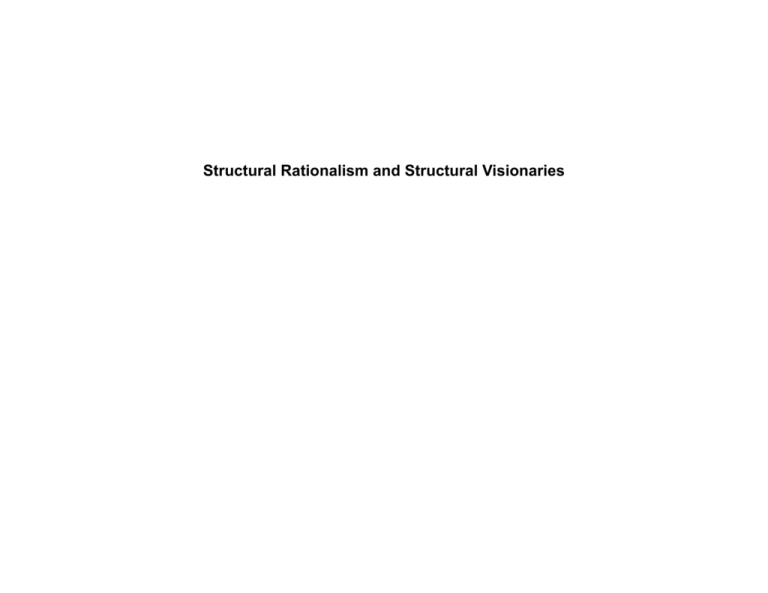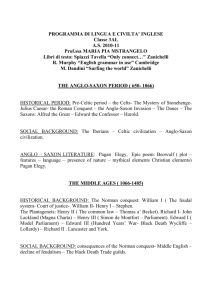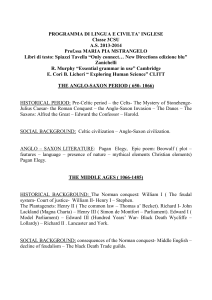3. July 3 Structural Rationalism
advertisement

Structural Rationalism and Structural Visionaries Eugène Emmanuel Viollet-le-Duc , 1814-1879 In architecture, there are two necessary ways of being true. It must be true according to the programme and true according to the methods of construction. To be true according to the programme is to fulfill exactly and simply the conditions imposed by need; to be true according to the methods of construction, is to employ the materials according to their qualities and properties…purely artistic questions of symmetry and apparent form are only secondary condition in the presence of our dominant principles. Eugène Viollet-le-Duc Conversations on Architecture, 1863-72 Eugene Emmanuel Viollet-Le-Duc, market place, Entretiens sur l’architecture, 1863-72 Viollet-Le-Duc, study for concert hall, Entretiens sur l’architecture, 1863-72 (Conversation on Architecture.) Viollet-Le-Duc, Study for a large hall Entretiens sur l’architecture, 1863-72 (Conversation on Architecture.) Eugene Emmanuel Viollet-Le-Duc, Iron details, Entretiens sur l’architecture, 1863-72 Victor Horta (1861-1947). Shown here ca. 1900 Alphonse Balat, Royal Winter Garden at Laeken, Belgium, 1874-76 Alphonse Balat, Royal Winter Garden at Laeken, Belgium, 1874-76 Jan Toorop, The Three Brides, 1893, Belgium, member of the post impressionist group, Les XX. Victor Horta, Hotel Tassel, Brussels, Facade, 1892 Victor Horta, Hotel Tassel, Brussels, plans and section, 1892 Victor Horta, Hotel Tassel, Brussels, Conservatory, 1892 Victor Horta, Hotel Tassel, Brussels, Central Hall, 1892 Victor Horta, Hotel Tassel, Brussels, Stair, 1892 Victor Horta, Hotel Tassel, Brussels, Detail of Door handle, 1892 Victor Horta, Maison du Peuple, Brussels, 1897-1900 Victor Horta, Maison du Peuple, Main Meeting Room, Brussels, 1897-1900 “…it was an interesting commission as I saw straight away – building a palace that wasn’t to be a palace but a ‘house’ whose luxury feature would be the light and air that had been missing for so long from the working-class slums…” Victor Horta on the Maison du Peuple. Hector Guimard (1867-1942), Studio, Castel Béranger, Paris, 1894-98. Hector Guimard, Ecole du Sacré Coeur, Paris, 1895. Eugene Emmanuel Viollet-Le-Duc, market place, Entretiens sur l’architecture, 1863-72 First subway, 1863 Baker Street Station, London Hector Guimard, Metro Station entry, Paris, France 1899-1904 Hector Guimard, Metro Station entry, Paris, France 1899-1904 Hector Guimard, Metro Station entry, Paris, France 1899-1904 Hector Guimard, Metro Station entry, detail, Paris, France 1899-1904 Hector Guimard, Metro Station entry, detail, Paris, France 1899-1904 Hector Guimard, Metro Station entry, detail, Paris, France 1899-1904 Hector Guimard, Metro Station entry, detail, Paris, France 1899-1904 Henry Van de Velde (1863-1957) Shown here c. 1890. Henry Van de Velde, Garden in Kalmhout, c. 1892, oil on canvas Henry Van de Velde, Abstract Plant Composition, c. 1893, pastel Henry Van de Velde, Angel Watch, c. 1893, tapestry Henry Van de Velde, Bloemenwert, house for himself, Uccle (near Brussels), 1895, Front and rear elevations. Henry Van de Velde, Bloemenwert, house for himself, Uccle (near Brussels), 1895, sketch plan. Henry Van de Velde, Bloemenwert, house for himself, Uccle (near Brussels), 1895 Henry Van de Velde, Bloemenwert, interior, Uccle (near Brussels), 1895 Henry Van de Velde, dresses for his wife, Maria published in Dekorative Kunst, 1901. “Samuel Bing’s” L’Art Nouveau Store, Paris, 1895 where Van de Velde first exhibited his furniture. Van de Velde’s “Smoking Room” exhibited at “Samuel Bing’s” L’Art Nouveau Store, Paris, 1895. “Yachting Style” “The same laws which guide the work of an engineer also guide ornamentation, which I would like to place on an equal footing with technology in this work. The new architecture needs new ornamentation. The reflection and suppleness characteristic of the former must also be features of the latter.” Van de Velde, ‘Das neue Ornament,’ in Die Renaissance im modernen Kunstgewerbe, Berlin, 1901. Henry Van de Velde, Chair for Bloemenwert House, Uccle (near Brussels), 1895 Henry Van de Velde, Furniture Atelier, Brussels, 1897 Henry Van de Velde, Study shown at the Secession exhibition in Munich, 1896 Henry Van de Velde, Tropon Poster, 1898. Only poster designed by Van de Velde Henry Van de Velde, Havana Cigar Store, Berlin, 1899-1900. Empathy vs. Abstraction “On the Acropolis the living standing columns teach us that they do not exist, that they do not carry load, or rather that they are interspaced according to an end very different from that for which they were apparently erected. Even where they are still joined by an entablature, they proclaim in evidence that the columns around the Parthenon do not exist, but that between them gigantic perfect vases are poised, containing life, space and sun, sea and mountains, night and the stars. The entasis of the columns is transformed until the resultant space between one and the other has attained a perfect, eternal form.” Henry Van de Velde, Frampton, p. 98 Henry Van de Velde, Art School and Applied Art School, Weimar, 1902-11, plan Henry Van de Velde in his studio on the upper floor of his Art School, Weimar, ca. 1907 Henry Van de Velde, Applied Art School, Weimar, 1902 Henry Van de Velde, Applied Art School, Weimar, 1904-11 Henry Van de Velde, Art School, Weimar, 1904-11 Henry Van de Velde, Art School, Weimar, 1904-11 Henry Van de Velde, Art School, Weimar, 1904-1911, staircase Henry Van de Velde, Model for Werkbund Theater, Cologne, 1913 Henry van de Velde, Werkbund Theater, Cologne, 1914, plan Henry van de Velde, Werkbund Theater, Cologne, 1914, section Henry Van de Velde, Werkbund Exhibition Theater, Cologne, 1914 Henry Van de Velde, Werkbund Exhibition Theater, Cologne, 1914 Henry Van de Velde, Werkbund Exhibition Theater, Cologne, 1914 Henry Van de Velde, Werkbund Exhibition Theater, Cologne, 1914 Henry Van de Velde, Werkbund Exhibition Theater, interior, Cologne, 1914 Italian Futurists and the Cult of the Machine First Airship Flight, Graf Zeppelin’s LZ 1, June 30, 1900. Wright Brothers’ first flight at Kittyhawk, 1903. The new Fiat S76, 1912. First to reach 131 mph. George Braque Chateau de La RocheGuyon. 1909 Pablo Picasso Ma Jolie (Woman with a Guitar) 1911-12 Umberto Boccioni, Self Portrait, 1908 Umberto Boccioni, Powers of a Street 1911 Umberto Boccioni, State of Mind, 1911 Umberto Boccioni, Bottle Unfolding in Space, 1912 Umberto Boccioni, Unique Forms of Continuity In Space, 1913 Umberto Boccioni, Burden of the Swordsmen, 1915 Antonio Sant‘Elia 1888-1916 Filippo Tomaso Marinetti, (center) with Umberto Boccioni on his left. Paris, 1912 Fiat S76, 1912. “Victory of Samothrace,” Louvre Museum, Paris, 240-190 B.C.E. Antonio Sant‘Elia Casa a Gradinata For Cittá Nuova 1914 Antonio Sant‘Elia Torre di Faro (Lighthouse) For Cittá Nuova 1914 Antonio Sant‘Elia Projects for La Cittá Nuova 1913-14 Antonio Sant‘Elia Project for Cittá Nuova 1914 Antonio Sant‘Elia Hydroelectric Dam La Cittá Nuova 1913-14 Antonio Sant‘Elia Central Railway Station and Airport Sketch for Cittá Nuova 1913-14 Antonio Sant‘Elia Central Railway Station and Airport For Cittá Nuova 1913-14 Giacomo Balla Futurist Clothing from Manifesto Futurista, 1914 F. T. Marinetti, Cover of magazine entitled: Zang, Tumb, Tuum: Adrianopolis, October 1912, Words in Freedom, 1914 Tony Garnier and Une Cite Industrielle Claude-Nicolas Ledoux, ideal city of Chaux, 1804 Ebenezer Howard’s Garden City from Tomorrow: A Peaceful Path to Real Reform, 1898. Tony Garnier (1869-1948) Tony Garnier, Cité Industrielle, plan, 1904-17 Tony Garnier, Cité Industrielle, plan, 1904-17 Tony Garnier, Cité Industrielle, aerial view, 1904-17 Tony Garnier, Cité Industrielle, aerial view, 1904-17 Tony Garnier, Cité Industrielle, detail of assembly building, 1904-17 Tony Garnier, Assembly Rooms portico, Cité Industrielle, 1904-17 Tony Garnier, Theater, Cité Industrielle, 1904-17 Tony Garnier, Public Bath, Cité Industrielle, 1904-17 Tony Garnier, Public Bath, Cité Industrielle, 1904-17, elevation Tony Garnier, hospital area , Cité Industrielle, 1904-17 Tony Garnier, hospital , Cité Industrielle, 1904-17 Tony Garnier, Train Station, Cité Industrielle, 1904-17 Tony Garnier, Art School, Cité Industrielle, 1904-17 Tony Garnier, Art School, Cité Industrielle, 1904-17, interior of main hall Main Hall, Ecole des Beaux Arts, Paris, where Garnier studied architecture Tony Garnier, housing , Cité Industrielle, 1904-17 Tony Garnier, Home Entry Courtyards, Cité Industrielle, 1904-17 Tony Garnier, Typical Apartment House, Cité Industrielle, 1904-17 Tony Garnier, port, Cité Industrielle, 1904-17 Tony Garnier, Power Plant, Cité Industrielle, 1904-17 Tony Garnier, Abattoir, La Mouche, Lyons, 1917, design Tony Garnier, Abattoir, La Mouche, Lyons, 1917 Tony Garnier, Abattoir, La Mouche, Lyons, 1917, as built Auguste Perret, Portrait by Theo van Rysselberghe 1914 Auguste Perret, 25 bis rue Franklin Paris, 1903 Auguste Perret, 25 bis rue Franklin Paris, 1903 Auguste Perret, 25 bis rue Franklin Paris, 1903 Auguste Perret, 25 bis rue Franklin, ground floor plan, 1903 Auguste Perret, 25 bis rue Franklin, apartment plan, 1903 Auguste Perret, 25 bis rue Franklin Paris, 1903. View from 7th Floor terrace Auguste Perret, 25 bis rue Franklin, Paris, 1903 rooftop view Auguste Perret, Théâtre des Champs-Élysées, Paris, 1911-13 Auguste Perret, Théâtre des Champs-Élysées, Paris, 1911-13, sectional axonometric Auguste Perret, Théâtre des Champs-Élysées, Paris, 1911-13, section Auguste Perret, Théâtre des Champs-Élysées, Paris, 1911-13, entry Auguste Perret, Notre Dame, Le Raincy, 1924. Auguste Perret, Notre Dame, Le Raincy, 1924, plan Auguste Perret, Notre Dame, Le Raincy, 1924. Auguste Perret, Notre Dame, Le Raincy, 1924. Auguste Perret, Notre Dame, Le Raincy, 1924, Stair detail Auguste Perret, Théâtre Exposition des Arts Décoratives Paris, 1925. Russian Constructivism Winter Palace, “The Hermitage,” St. Petersburg, Russia, 1754-1762 Carlo Rossi, Carlo Rossi Street, St. Petersburg, Russia, c. 1830 Alfred Parland, Church on Spilt Blood, St. Petersburg, Russia, 1881 Victor Vasnetsov, Chapel, Abramtesvo, Russia, 1882 Influences from the West Ernst Ludwig Kirchner Portrait of a Woman 1911 George Braque Chateau de La Roche-Guyon. 1909 Pablo Picasso Ma Jolie (Woman with a Guitar) 1911-12 Umberto Boccioni, Unique Forms of Continuity In Space, 1913 Antonio Sant‘Elia Torre di Faro (Lighthouse) For Cittá Nuova 1914 Kazimir Malevich, Self-Portrait, 1912 “Mystical Idealist” Kazimir Malevich, “Black Square,” 1915 Kazimir Severinovich Malevich, Suprematist Compostition: Airplane Flying, 1915 Kazimir Malevich, “Malevich pictures in ‘0.10’ exhibit, St. Petersburg, December 1915,” “the appropriate means of representation is always the one which gives fullest possible expression to feeling as such and which ignores the familiar appearance of objects.” Malevich Black square = feeling, white=void beyond the feeling. Suprematism. Kazimir Malevich, “Suprematist Composition: White on White,” 1918 El Lissitzky, Self-Portrait: The Constructor, 1924 Agit-Prop Train, 1919 El Lissitzky, “The Factory Workbenches Await You.” Propaganda Board in Vitebsk, 1919-20 El Lissitzky “A Supremist Tale about Two Squares: 6. ‘They Fly on to the Earth from far away and…’ 1920 El Lissitzky Design for The Lenin Tribune, 1920 El Lissitzky, “Proun. [Project For the Affirmation of the New] N 1-A,” 1921 El Lissitzky, Proun 19D, 1922 El Lissitzky, Proun Room, 1923 El Lissitzky, Cloud Hangar Project, 1925 El Lissitzky, Skyscraper near Nikitskii Gates, 1925 Eliel Saarinen, Chicago Tribune Competition entry, Chicago, 1922 Vladimir Tatlin (1885-1953) wearing coat he designed and in front of a stove he designed in 1919. Vladimir Tatlin, Corner Relief, Suspended Type, 1915 “Productivist” Vladimir Tatlin Monument to 3rd International, St. Petersburg, 1920, elevation Vladimir Tatlin Monument to 3rd International, St. Petersburg, 1920, model Alexandr Rodchenko, 1920. Alexandr Rodchenko, “Non-Objective Painting: Black on Black,” (MOMA) 1918. Alexandr Rodchenko, Spatial Constructions on view at the Second Spring Exhibition of the Society of Young Artists, 1921. Alexandr Rodchenko, Design for the insignia for the state airline Dobrolet, 1923. Alexandr Rodchenko, Workers’ Club, Paris, 1925 Aleksandr and Victor Vesnin, Moscow, Palace of Labor competition, 1922-23 Alexandr and Victor Vesnin, Leningrad Pravda Building Competition, Leningrad, 1924 Elevation Konstantin Melnikov, (1890-1974) Konstantin Melnikov, Sucharev Market, Moscow, 1924-25 (ASNOVA Assoc. of New Arch.) Konstantin Melnikov, USSR Pavilion, Exposition des Arts Decoratifs, Paris, 1925, elevation Konstantin Melnikov, USSR Pavilion, Exposition des Arts Decoratifs, Paris, 1925, plans Konstantin Melnikov, USSR Pavilion, Exposition des Arts Decoratifs, Paris, 1925 Des Galeries Lafayette (Department Store) pavilion, Exposition des Arts Decoratifs, Paris, 1925 Le Corbusier, L’Esprit Nouveau, Pavilion, Exposition des Arts Decoratifs, Paris, 1925 Konstantin Melnikov, Rusakov [Tram] Workers’ Club, Moscow, 1927-28, plan and section Konstantin Melnikov, Rusakov [Tram] Workers’ Club, Moscow, 1927-28 Konstantin Melnikov, Rusakov [Tram] Workers’ Club, Moscow, 1927-28 Konstantin Melnikov, Melnikov House, Moscow, 1927-28 Moisei Ginsberg and Ignati Milinis, Narkomfin Apartment Building, Moscow, 1928-30. Moisei Ginsberg and Ignati Milinis, Narkomfin Apartment Building, Moscow, 1928-30. Moisei Ginsberg and Ignati Milinis, Narkomfin Apartment Building, Moscow, 1928-30. Ol, Ivanov and Lavinsky, interlocking duplex apartments with central corridor, OSA (Organization of Comtemporary Architecture) competition, 1927 [left]; Design for a compact kitchen module with concealing screens, by the Building Committee of the Economic Council of the USSR. El Lissitzky, Model for Type “F” residential unit, Narkomfin, Moscow, 1929. Ivan Leonidov, c. 1920 Ivan Leonidov, Design for Lenin Institute of Librarianship, 1927 Ivan Leonidov, Design for Lenin Institute of Librarianship, 1927, model Ivan Leonidov, Design for Lenin Institute of Librarianship, 1927, model Ivan Leonidov, Project for a Palace of Culture, from the cover of SA, 1930, showing (left to right) the ‘physical culture sector,’ ‘field for demonstrations’ and ‘popular activities sector’ Frampton, p. 175 Ivan Leonidov, project for Magniogorsk, 1930. A 20-mile road links an industrial plant for mining iron to an agricultural commune in the interior. Frampton, 177.

